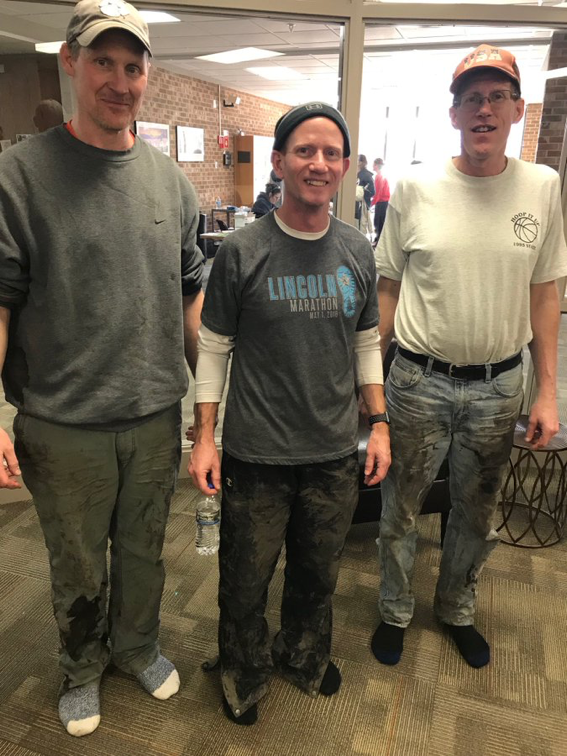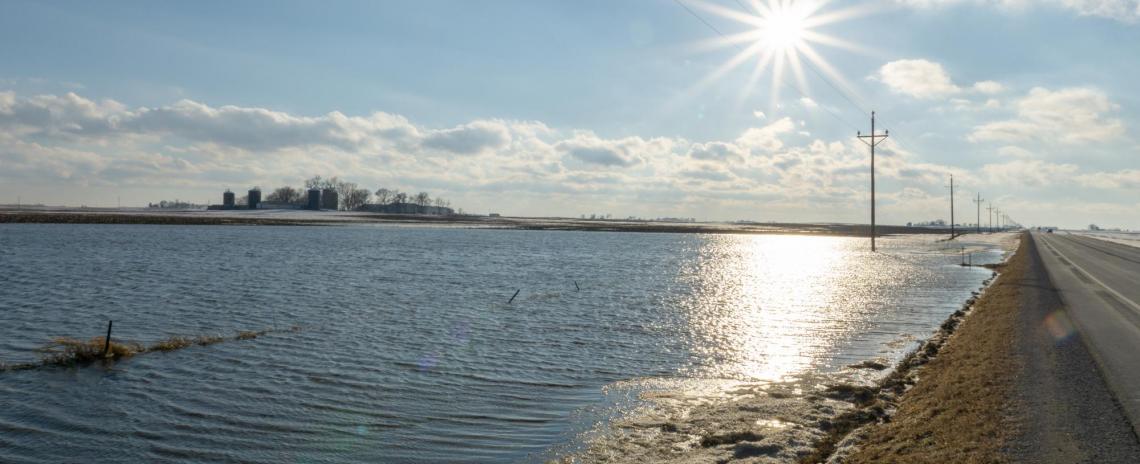Finding the Remarkable in Flood's Heartbreaking Aftermath
Finding the Remarkable in Flood's Heartbreaking Aftermath
By Tyler Dahlgren
Part 1: North Bend
The superintendent walks through the central office doors, out into the commons and down a walkway leading to Tiger Arena.
School’s out for the summer, but North Bend Central’s hallways still buzz with energy as teachers shore up end-of-the-year odds and ends and next week’s state track participants come in and out of the building.
“What are you guys doing here?” Dr. Dan Endorf jokes. “You know school’s over, right?”
The track stars laugh, pick up their pace and disappear off to practice. They’ll represent the Tigers on the state’s biggest stage. They’ll represent their small town, 15 miles west of Fremont near the banks of the Platte River.
A proud community that, just two months ago, had nowhere to go. Nowhere but here.
Dr. Endorf continues his tour. North Bend Central feels like a school again, but when the levee broke in March and devastating flood waters swarmed the town and displaced many of its 1,200 residents, this building became a safe haven.
Endorf enters the gym and, though completely empty and peaceful on this May morning, thinks back to what Tiger Arena became during those 10 days after the flood.
“That door over there,” he points to his right, “leads to the industrial arts room. Donations would come into that room and they would be inventoried and brought into this gym, which became a donation expo, or a grocery store of sorts, chalk-full of items.”
Endorf opens the door to the school’s library. While North Bend citizens worked towards restoration, this became a daycare. One classroom became a UPS/FedEx station. Another housed the command center, where Endorf would run through assignments at the beginning of daily meetings with the city council and other town officials.
“City Council, volunteer fire department, and several other groups just stepped up and filled some very important needs and roles,” Endorf said. “We had mental health counselors in a math room. People really needed it. We had kitchen staff working tirelessly, because people needed food. Most of it was donated, from near and far.”
North Bend’s streets were completely under water. Helicopters captured shocking images from the sky and airboats both brought supplies to those stationed in town and helped transport those who needed out.
“Both of our schools, thankfully, were bone dry,” said Dr. Endorf. “Since we were dry, and it is a huge facility, it provided us an opportunity to assist the town in the preparation and recovery from the flood.”
The Tuesday before the flood, the city council became concerned of a potential disaster and called for an emergency meeting. Endorf, who grew up in Tobias, NE, where droughts are common on an annual basis, said that meeting helped him understand the severity of what could be in the cards.
He offered Tiger Arena, a gorgeous facility constructed after the town passed a bond issue in 2013, as an evacuation site. Tiger Talk, the district’s electronic communication system, because the city’s primary means of transmission. The local newspaper played a vital role in communication too, through the utilization of social media.
It was all hands on deck as the town moved into the school.
“Our taxpayers support us to the highest degree,” he said. “There were no second thoughts when it came to providing this facility to aid the patrons of this district.”

(From left to right, teachers Aaron Sterup (English), Todd Ziettlow (math) and Fred Ladehoff (science) work as a team to help those residents impacted by the flood. "This photo is near and dear to my heart," said Dr. Endorf.)
Commissioner of Education Dr. Matt Blomstedt had visited North Bend, along with a handful of other districts severely affected by the flood, the day before NCSA’s visit. What he saw, and the stories he heard, were heartbreaking, and, yet, at the same time, remarkable.
“In North Bend, the schools were somehow not impacted and became the center for the operation,” Dr. Blomstedt said. “Folks came together, volunteered and worked unbelievably hard. These are remarkable, heroic stories, but mostly it’s the story of people relying on one another and continuing to rely on one another, and that’s the beauty of what happens in Nebraska’s schools all the time.”
North Bend’s story isn’t about a flood, explained Dr. Endorf, but rather one of a town, a school, and a recovery.
“The story here is a community of heroes.”

Part 2: Boyd County
Water seeped into the building in Lynch first, the night before disaster struck.
Boyd County Elementary School Principal Cindy Johnson and her custodial staff spent hours vacuuming up water in an attempt to stay ahead of predicted flooding.
Thursday morning, the Spencer Dam along the Niobrara River collapsed, giving way to catastrophe. Boyd County Public Schools, with buildings in Lynch, Spencer and Butte, let out school immediately as a rolling current methodically blanketed the connecting Highway 12.
Friday morning, Boyd County Superintendent Michael Brown met with Johnson and 6-12 Principal Matt Korkow, and the trio of administrators agreed the first step that needed to be taken was assessment. They evaluated facilities and checked on the welfare of their students and families.
Brown made the decision to call off school for the entire next week.
“Not because our facilities were so much affected, but because our families were so affected,” he said. “Kids were so much more essential at home, helping their families.”
Much like what transpired at North Bend and schools across the state, Boyd County Elementary’s gymnasium was quickly filled with supplies. Bottled water, clothing, shoes and food, stocked to the max.
“You name it, we had it,” said Brown. “For almost a month, we became the donation center in Lynch.”
While kids weren’t in class, they were certainly helpful. Students played a key role in the clean-up process in Lynch and unloaded truckload after truckload of supplies at emergency centers. Brown was proud of the courage the district showed throughout the recovery process, one that continues to this day.
“Our kids are very tough, and showed a lot of fortitude,” he said. “As did our teachers. Every time you went to one of the distribution centers, there they were, unloading a truck or cleaning a house. Everybody pitched in and did what they could.”
Residents of Spencer and Lynch were still without drinkable water at the end of May. Two bridges to the south were completely wiped out, leaving the county a virtual extension of South Dakota.
“For us to get south, you have to go across a pretty rough gravel road, or you have to travel 60 miles out of your way to go around,” Brown said. “We are still impacted that way. It really affected busing routes, and our transportation to student activities. Fuel costs are skyrocketing right now, not to mention our county roads are in very poor shape.”
Boyd County is a county-wide district stretching 50 miles. They cover a lot of ground, and effective communication through the ordeal was vital. The school’s alert system allowed community-wide text messages to keep folks on the same page during recovery.
“We had to stay in constant communication with our families,” Brown said. “There are some students who we couldn’t get to, and they couldn’t get to us. People had to meet our buses at highways, just to get the kids to school.”
Though Boyd County currently exists on an island of sorts, nearly disconnected from the rest of the state, school staff did its best to finish out the school year. As the governor visited and those without running water in the county showered at the school building in Butte, staff tried to establish normalcy for their students.
“Sometimes, with our younger kids, certain stories will bring them back to the flood, and we have to be cognizant of that,” said Johnson. “The teachers are doing a great job at that, being understanding and supportive of each of their students and their respective situations.”
Part 3: NDE
The historic flood directly impacted 89 of the state’s 244 public school districts, with more than 60 having to close down for some period of time, but no two towns share the same story.
“Each story, even if they were coming from districts in close approximation to one another, were different for different reasons,” said Dr. Blomstedt. “The flood impacted places and schools differently, but it impacted them all dramatically.”
Like districts throughout the state, NDE did its best to brace for the flood. On Friday, March 15, the commissioner communicated with his staff and asked them to be prepared to meet the following week.
“We were gearing up, and then it got a lot worse,” he said. “The weekend was more severe than predicted, and it just kept building. It was a snowball effect, and, with the blizzard in the western part of the state, that’s what it truly was.”
Blomstedt sent another email to his staff over the weekend, establishing a time for everyone who felt they could contribute to meet on that Monday, and every Monday moving forward. The focus group used chart paper to map out assistance they anticipated each area might require in the flood’s aftermath.
“It was nothing compared to what the folks actually dealt with on the ground level, but I was very pleased with how our team responded through all of that,” said Dr. Blomstedt, who was in contact with and seeking support from the U.S. Department of Agriculture and the U.S. Department of Education. “Moving forward, there might be some additional federal funds we can tap into together. Instead of having 15 to 20 different grant applications out there, we are thinking of ways we can consolidate that effort and have one application or one way to manage that and make sure costs that wouldn’t otherwise be covered are covered.”
Nebraska continues to heal. Commissioner Blomstedt is still in awe of educational leadership throughout the state-how even superintendents impacted the most were constantly asking what kind of assistance other districts needed.
“After the flood, there was a conference call involving 60 or so superintendents and several ESU people,” Blomstedt said. “Many of them weren’t directly affected. They were just on the call to be helpful. That’s a very Nebraska story, in terms of other people giving up their time to do that.”
The stories will stick with Dr. Blomstedt through the recovery process and long after. Stories of students being put up in hotels and community members taking in kids and keeping them safe. Stories of dead fish being found in freshly-laid mulch on school grounds and of playgrounds being treated for E. Coli. Stories of bravery and stories of schools rising to the challenge of rescue for their towns and their families.
“The schools just felt very normalizing in an otherwise chaotic situation, and that was brought up often,” Dr. Blomstedt said. “They were the center of activity through this, not just for the kids but for families as a while. And for people not otherwise connected to the school setting, the elderly and others who needed support.”
Part 4: The Nebraska Spirit
The notes still sit on Endorf’s desk.
Letters of support from districts near and far. In the envelopes, between the cards filled with well-wishes, he finds monetary donations. They mean more to him and the school than anyone will ever know.
“I know that I owe thank you notes to countless schools across Nebraska that sent well-wishes, monetary donations and other acts of kindness to NBC,” Dr. Endorf said. “My faith is humanity has never been higher after experiencing that outpouring of generosity.”
The community and school board recognized the need for one day prior to the return of students for the NBC staff to reassemble, clear their minds and set the path to providing a great academic experience for their students, most who had experienced loss of some kind, the next day.
“When our students and staff were reunited after two weeks of no school, it felt like August,” said Dr. Endorf. “There was an August-type excitement in this building that carried us through the rest of the school year.”
There were no April doldrums in North Bend.
Johnson said Boyd County Public Schools received nearly $9,000 in donations from other schools, most from Nebraska and some from South Dakota and Wyoming.
“We had four families, staff or students, who lost their homes to the flood, and we’ve been able to give them close to four-thousand dollars in donations to help them recover,” said Johnson. “It was amazing how much assistance we received. It shows the spirit of helping people is still alive and well.”
*This feature story first ran in the summer edition of the NCSA Today magazine.


